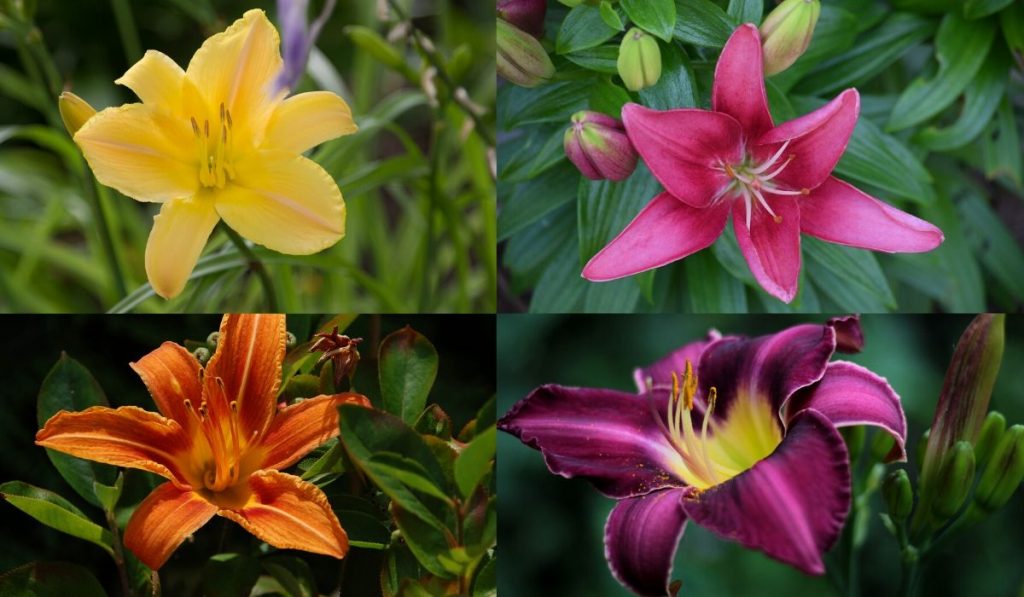Known for their flowers that bloom in just a day, daylilies or Hemerocallis spp. have always been a favorite of many gardeners and flower breeders across the globe. These alluring plants are often regarded as the “perfect perennial” for many reasons.
Not only do they produce plenty of flowers in different colors, shapes, and sizes, but they also adapt to various planting conditions. Read on to know more about the beautiful daylilies.
Daylily Facts

Name and Origin of Daylilies
Daylilies are flowering plants native to Asia. Although some reports note that daylilies are part of the Lily (Liliaceae) family, they are not, in fact, true lilies. This perennial used to be part of the Liliaceae family but is now part of the Asphodelaceae family under the genus Hemerocallis.
The genus name Hemerocallis originates from the Greek word hemera, which means “day”, and kallos, which means “beauty”. The “beautiful for a day” translation refers to the fact that each daylily flower remains open for only a day (1).

Traditional daylilies come in yellow, orange, or reddish-yellow (2). However, since these plants have always been a subject of hybridizations as early as the 1930s, especially in the United States and England, they now come in diverse colors including white, yellow, pink, red, purple, crimson, and many others (2).
Daylilies have long been well-recognized in China for their medicinal and edible uses. By the 16th century, this attractive plant played a part in European trading and eventually reached home gardens in various parts of Europe. By the 17th century, daylilies got as far as North America.
Renowned botanist Dr. Arlow Burdette Stout led a breeding program for daylilies that produced at least 100 new varieties of the legendary flower. Because of his contributions, he is dubbed as the “father of modern daylily”.
Uses

Known as one of the easiest flowering plants to grow, daylily plants make an excellent choice for perennial beds and shrub borders. They add color to any landscape, especially during the summer.
Smaller types of daylilies are excellent plants of choice for container gardening. Moreover, the beautiful and carefree perennial also makes an excellent ground cover on sloped areas since the roots can hold against soil erosion once fully established (2).
General Description and Characteristics
Daylily plants have erect and leafless flower stalks called scapes, which emerge from the crown and extend above the foliage. The crown is the plant part between the root and the leaves (3).
For most daylily cultivars, the flower scapes reach about 1 to 5 feet in height. Modern cultivated varieties typically produce 15 or more daylily flowers per scape.
Daylily Flowers
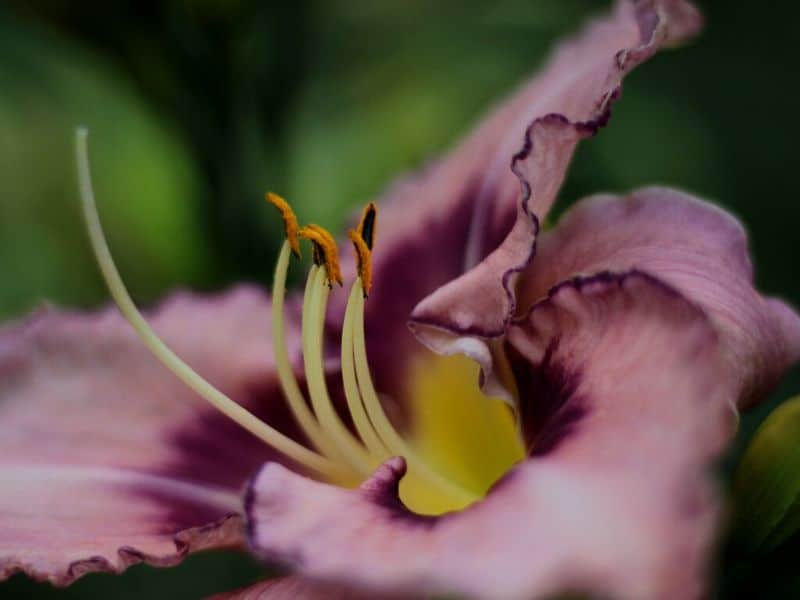
Individual daylily flowers last for only a day, but the plant produces a succession of blooms for three to four weeks. However, other cultivated varieties of daylilies bloom for more than ten weeks. One example is the ‘Stella de Oro’ variety (3).
The majority of cultivars bloom early to mid-summer. Early flowering cultivars, however, bloom in late spring to early summer. Other daylily cultivars bloom late summer to frost.
Flower diameter typically measures about 2 inches to 8 inches or more. Multiple flower colors are available depending on the variety, with pure white and true blue being the only exceptions (3).
Daylily flowers take different forms or shapes depending on the variety, such as circular, triangular, star, ruffled, spider, recurved, trumpet, and double (4).
- Circular daylily flowers are full and rounded in shape.
- Triangular daylily flowers have flower segments that form a triangle when viewed from the front of the bloom.
- Star-shaped daylilies form a flower shape comparable to a three-pointed or six-pointed star.
- Ruffled daylilies have flowers with ruffles along the edges.
- Spider daylilies have narrow and spider-like petals. The tips may be slightly curled.
- Recurved daylilies produce flowers with ends of the segments tucked under.
- Trumpet daylilies bear trumpet-shaped flowers that resemble a true lily.
- Double daylily flowers have more than six segments.
Daylily flowers can further be classified depending on their sizes. Miniature daylilies have flowers with less than 3 inches in diameter. Small daylilies produce flowers that measure 3 to 4.5 inches in diameter. Large daylilies, on the contrary, have blooms that measure at least 4 inches in diameter (4).

Daylily Foliage
Most daylilies have dormant foliage, which dies back to the ground in the fall season. Other daylilies, however, have evergreen or semi-evergreen type of foliage. Daylilies with evergreen foliage retain their leaves throughout the year.
Semi-evergreen daylilies, on the other hand, are a mix between dormant and evergreen. Their tender foliage habit differs depending on the climate. This type of daylilies acts like evergreen daylilies when planted in a warmer climate, but sheds their foliage if planted in colder areas.
Daylily leaves are grass-like, long, linear, and grows about 1 to 2 feet long. Each leaf has a striking central rib on the underside. The leaves are opposite each other from the crown (3).
The Differences Between Daylilies and Lilies
People often get confused with daylilies and lilies, probably because of the plant names or perhaps the appearance of their blooms. The two plants, however, are entirely different.
Although both are perennials, daylily and lily belong to different botanical families. Daylilies (scientific name Hemerocallis) are from the Asphodelaceae family, while lilies are from the Liliaceae family.
Daylily flower stems, which are technically called scapes, are generally much shorter than the stems of lilies. The scapes also grow from a clump of grass-like leaves at ground level. The stems of lilies, on the other hand, are longer with leaves up the entire stalk.
The flowers have distinct differences as well. While lilies always have six petals, daylily flowers usually have two layers of three. The top layer consists of three real petals, while the bottom layer consists of three petal-like sepals. Besides, individual lily flowers last two to three weeks while individual daylily flowers last for only a day.
Popular Daylily Varieties
Truly a versatile ornamental, daylily offer the “right” variety for every garden. Called by many plant enthusiasts “perfect perennial”, daylily shares a countless number of cultivated varieties of different colors, shapes, and sizes. Learn about the most popular and well-received varieties of daylily below.
‘Stella de Oro’ Daylily
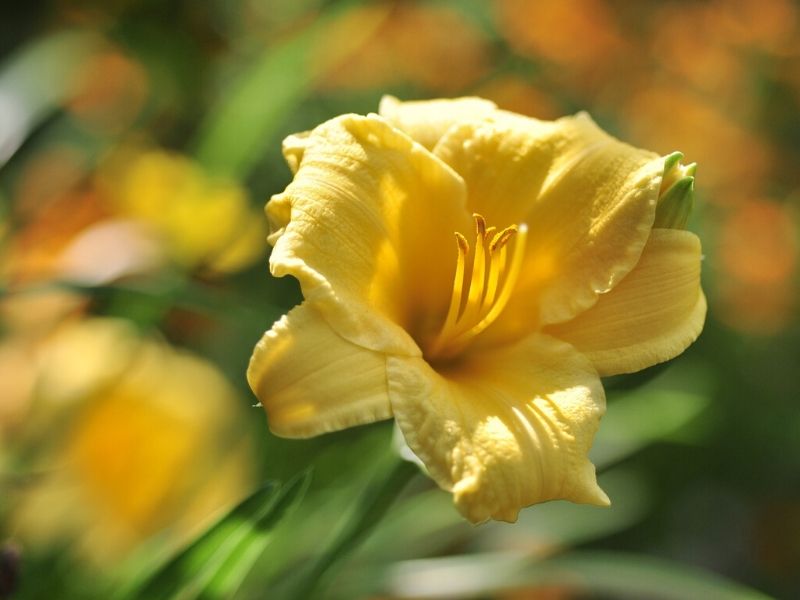
When referring to daylilies, one hybrid variety that probably stands out the most is the ‘Stella de Oro’ daylily. Perhaps the most popular and widely grown daylilies in the world, this hybrid is known for its adaptability to a variety of planting conditions and the ability to rebloom for long periods. It requires full sun but tolerates part shade.
The ‘Stella de Oro’ cultivar grows and spreads up to 1 ft. The fragrant, compact, yellow flowers typically measure about 2.75 inches in diameter and characterized by ruffled edges and deeper throats.
This variety blooms early to late summer.
‘Chicago Silver’ Daylily
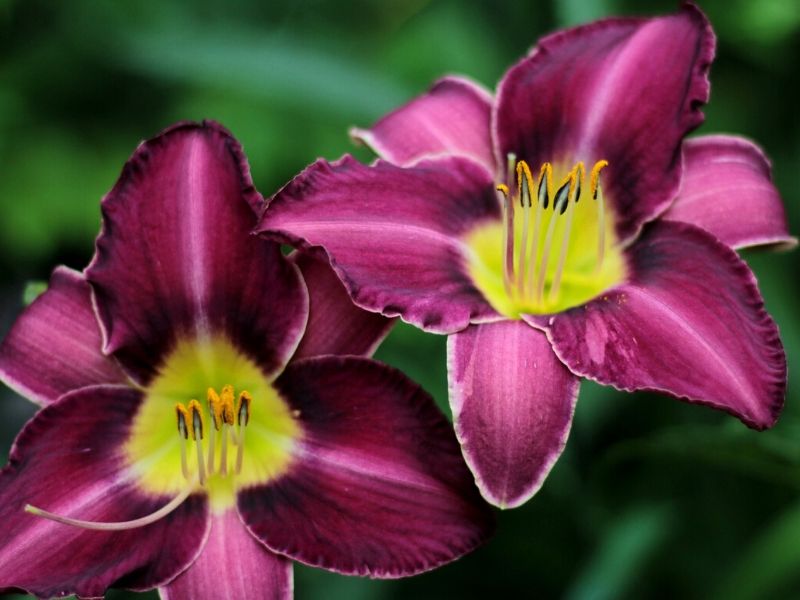
Hemerocallis ‘Chicago Silver’ is a semi-evergreen daylily that grows about 24 to 36 inches in height. The flowers are purple with darker eye zone, silver edges, and green throat. Individual bloom reaches up to 6 inches in diameter.
‘Chicago Silver’ daylilies are midseason bloomers.
‘Crimson Pirate’ Daylily
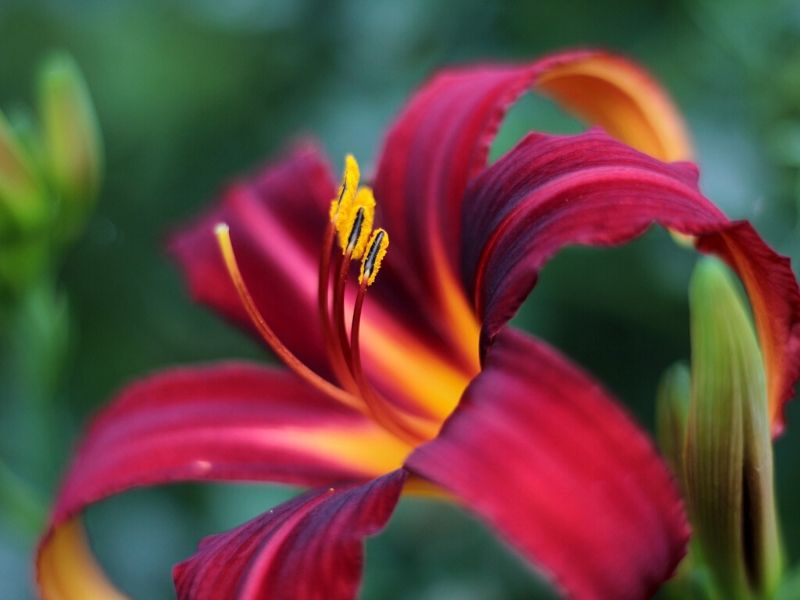
Daylily ‘Crimson Pirate’ or Hemerocallis ‘Crimson Pirate’ is one of the many favorite red selections of this beautiful perennial plant. The blooms appear in bright crimson red with lighter midrib and darker eye. The throat comes in yellow, which gives just the right contrast for an attractive look.
An individual flower grows up to 4 inches in width and lasts until 16 hours, but no more than 24 hours. ‘Crimson Pirate’ daylilies are midseason bloomers and rebloomers.
‘Barbara Mitchell’ Daylily
‘Barbara Mitchell’ daylilies are another top pick for many gardeners. This cultivar presents soft pink blooms with full petals and measures up to 6.5 inches (4). This semi-evergreen daylily is an early midseason bloomer and a rebloomer. The flower form is single.
This famed daylily grows up to 20 inches in height.
‘Catherine Woodbury’ Daylily

‘Catherine Woodbury’ daylilies produce fragrant lavender-pink trumpet-formed blooms with a yellowish throat and slightly ruffled petals. Flowering occurs late midseason with an extended bloom period (4).
The plants reach about 2 to 3 feet tall, with flowers growing up to 6 inches in full size.
‘Ice Carnival’ Daylily

This multi-awarded daylily features huge and ruffled pale yellow to white blooms with yellow-green throat. Each flower reaches up to 6 inches in full size and blooms mid-summer with a slight rebloom. Mature ‘Ice Carnival’ daylily plants grow up to 18 inches in height and 30 inches in width.
‘Moonlit Masquerade’ Daylily
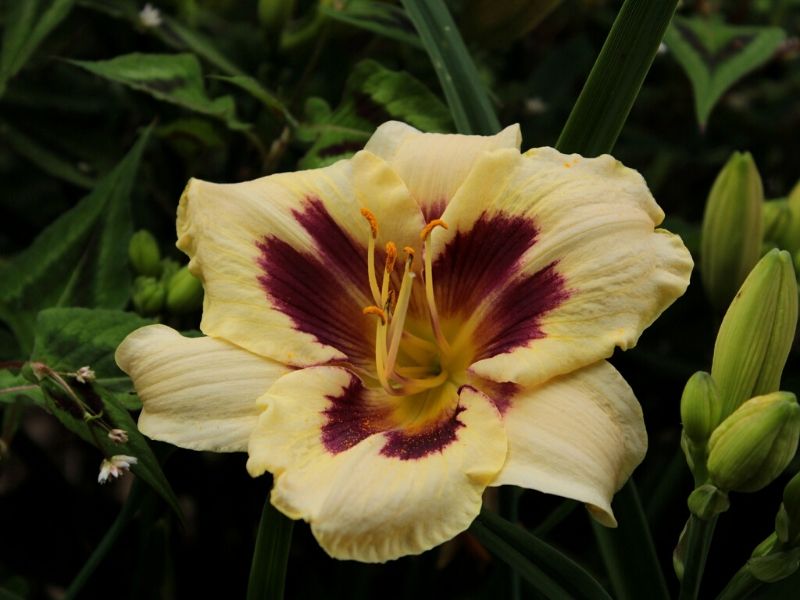
With its gorgeous, large, cream blooms with unique purple eye zone and green throat, the ‘Moonlit Masquerade’ is easily one of the most recognizable daylily cultivars available. It blooms early midseason. This stunner is a highly recognized reblooming daylily.
This tetraploid and semi-evergreen daylily has won multiple awards over the years, including Stout Silver Medal in 2004 and Award of Merit in 2002, among others.
How To Care For Daylilies
Although daylilies are tough and one of the easiest perennials to grow, their best form and flowering can only be achieved if proper cultural practices are done.
Planting Daylilies
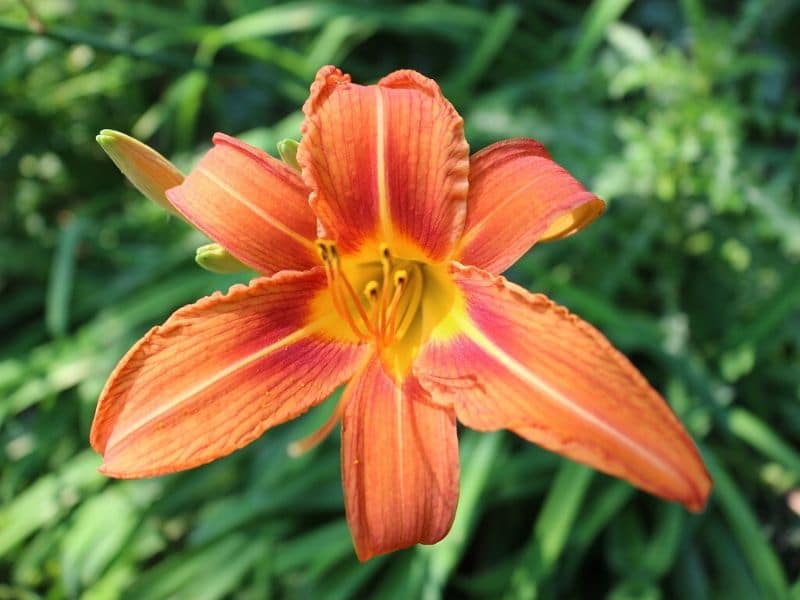
These plants have fleshy roots that require well-drained and moist soil. Plant daylilies with 18 to 24 inches spacing between plants. The crown, the area where the roots and shoots meet, must be planted level with or slightly below the soil surface to achieve optimum growth.
Growing daylilies too deep, burying the crown excessively, may result in weak growth and minimal flowering.
One successful planting method for daylilies is called the “cone method”. This planting method creates a cone-shaped pile of loose soil at the bottom of the hole to hold the plant roots. The roots are then spread over the cone and packed lightly with soil. Water it after planting.
Generally, daylilies thrive best under at least 6 hours of sunlight, but other brightly-colored blooms tend to fade when exposed to full sun (2). Daylily flowers open to face the sun or in the direction of bright light.
These perennial flowering plants prefer moist soil and require additional watering if rainwater is not enough. Deep irrigation is advised since the overhead type may cause damage to the flowers. Watering should be done in the morning to avoid the occurrence of leaf diseases (5). Mulching helps in conserving moisture and controlling weeds (2).
Maintenance of Daylily Plants
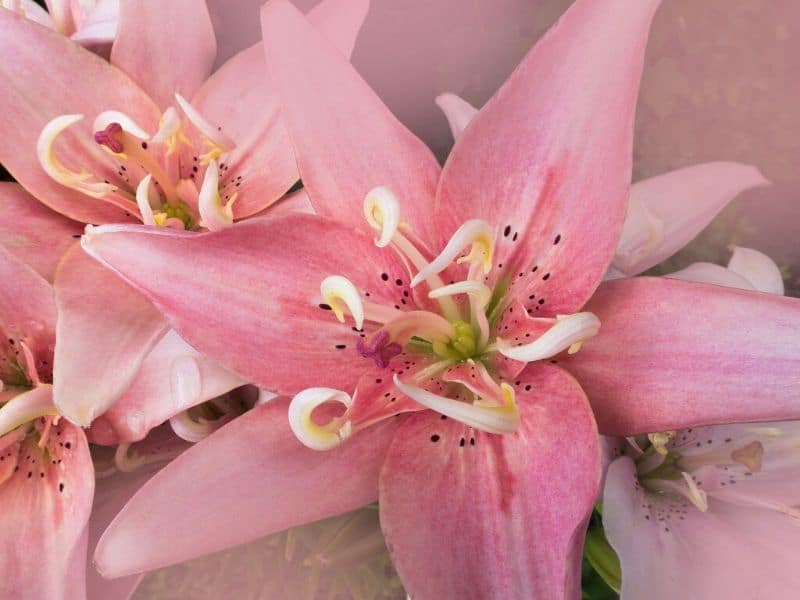
Daylily plants require little to no maintenance, but some care will keep these perennials looking at performing at their best. It is best to remove any decaying or dead foliage around the plants during the winter. After flowering, remove spent blooms and seed pods. The flower stalk can also be cut close to ground level once all the flowers are finished blooming (2).
When and how to divide daylilies?
Daylilies multiply by growing new fans or individual units of daylily plants containing the leaves, crown, and roots that are identical to the mother plant. The group of fans is referred to as daylily clumps.
Newly planted daylilies typically don’t need division for the first 3-5 years, as their clumps haven’t had time to become overcrowded. However, transplanting daylilies through clump division is recommended for established clumps when they become too thick, causing individual plants to produce fewer and smaller blooms.
Early spring and late summer to early fall are the ideal times of year to do daylily division since the plants will respond well to rejuvenation.
Dividing daylilies after the blooming period (2). Cut the leaves down to 6 to 8 inches in height using a pair of hedge shears. Loosen the soil around the clump and dig up the entire clump. Then, using a garden fork or spade, physically separate the daylily clump with each portion having at least four fans. Replant at the same soil depth.

Pests and Plant Diseases
Although daylilies are tough perennials, there are still several pests and diseases that may affect and damage these plants.
Some of the most common diseases of daylilies include daylily streak and daylily rust (6). The former is caused by the fungus Aureobasidium microstictum and often occurs under wet and cold conditions (7).
Symptoms of daylily streak include yellow streaks that are visible along the central vein of the leaves. These yellow streaks, which are often found at the tip of the leaves and progresses downwards, can darken and turn to brown (7). Affected leaves may wither and die completely (6).
Daylily rust is caused by the fungus Puccinia hemerocallidis. Infected plants display yellow to brown leaf streaks with numerous small orange spots called pustules on the undersurface of the leaves. The pustules further develop as the disease progresses and release dusty spores (8).
Thrips and mites are the most common insect pests of daylilies. If not properly controlled, these insect pests may cause injury to the plants, including the flowers.
Thrips usually damage the flower buds and tender branches. Mites, on the other hand, feed on the leaves by sucking out the juices (9). The use of pesticides is advised (5).
Other insect pests of daylilies include aphids and slugs.
Toxicity
Daylilies are not poisonous to humans and dogs but may cause serious harm to cats. The entire plant is toxic to cats, including the stem, leaves, and flowers. When ingested, daylilies may cause excessive drooling, vomiting, loss of appetite, and kidney failure (10).
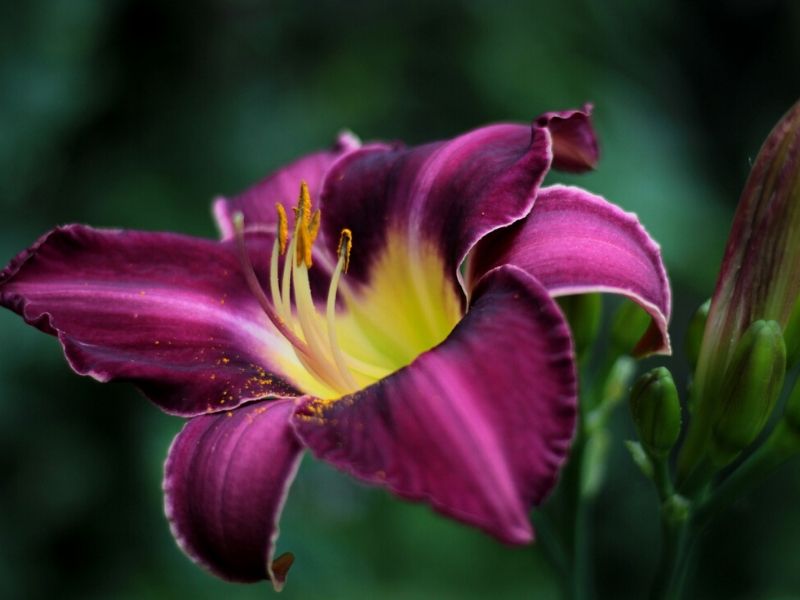
Meaning and Symbolism
There are different meanings and symbolism of daylily flowers. One distinct characteristic of this beautiful garden flower is its bloom behavior. Daylilies bloom in the sunrise and wither at sunset. Because of such, the flower is often linked with coquetry or flirtatious behavior.
Daylily flowers also symbolize motherhood, particularly in China, where it represents a mother’s devotion.
Since there are countless colors available for daylilies, each color further gives different meanings. Like most white flowers, white daylilies symbolize purity, innocence, honesty, and perfection. They are also associated with the Virgin Mary and usually deemed by many as a Holy flower.
Yellow daylilies signify joy and new beginnings while red daylilies denote passion, love, and devotion. Orange daylilies, on the other hand, symbolize love, beauty, and courage.
FAQs
Do daylilies like direct sunlight?
Yes, daylilies (Hemerocallis) generally prefer direct sunlight to thrive and produce abundant blooms. Plant them in a location where they can receive at least 6-8 hours of sunlight per day for optimal flowering.
How do you get daylilies to keep blooming?
To encourage daylilies to keep blooming, deadhead spent flowers regularly throughout the blooming season. Removing faded blooms prompts the plant to redirect energy into producing new flowers rather than seed production. Additionally, provide them with adequate water and fertilizer to support continuous blooming.
Where do daylilies grow best?
Daylilies grow best in well-draining soil with plenty of sunlight. They can tolerate a range of soil types, from sandy to clayey, but prefer fertile soil rich in organic matter. Plant them in a location with good air circulation to help prevent fungal diseases and maintain healthy foliage.
Do daylilies need to be cut back?
While daylilies do not require regular pruning like some other plants, you can cut back their foliage after flowering to improve the plant’s appearance and promote new growth. Additionally, dividing crowded clumps every few years can rejuvenate the plants and prevent overcrowding, leading to better flowering.
Check out our article on perennial plants and flowers for more information about flowers similar to daylilies.
See more: Daylily companion plants
References
Reference List:
- Bellarmine.edu. (2019). Dwarf Daylily. [online] Available at: https://www.bellarmine.edu/faculty/drobinson/DwarfDaylily.asp
- Strickland, J. (2018). Daylilies Are More Than Roadside Lilies. [online] Wayne.ces.ncsu.edu. Available at: https://wayne.ces.ncsu.edu/2018/06/daylilies-are-more-than-roadside-lilies/
- Rindels, S. (n.d.). Daylilies. [ebook] Available at: https://store.extension.iastate.edu/Product/Daylilies-PDF
- Polomski, B. and Russ, K. (1999). Daylily. [online] Home & Garden Information Center | Clemson University, South Carolina. Available at: https://hgic.clemson.edu/factsheet/daylily/
- Pss.uvm.edu. (2019). Daylilies. [online] Available at: http://pss.uvm.edu/ppp/pubs/oh33.htm
- Center for Agriculture, Food and the Environment. (2015). Daylily Rust and Daylily Streak. [online] Available at: https://ag.umass.edu/greenhouse-floriculture/fact-sheets/daylily-rust-daylily-streak
- Hyg.ipm.illinois.edu. (2020). Home, Yard & Garden Newsletter at the University of Illinois. [online] Available at: http://hyg.ipm.illinois.edu/article.php?id=383
- Plantclinic.cornell.edu. (2020). [online] Available at: http://plantclinic.cornell.edu/factsheets/daylilyrust.pdf
- Ccenassau.org. (2020). [online] Available at: http://ccenassau.org/resources/-daylilies
- U.S. Food and Drug Administration. (2019). Lovely Lilies and Curious Cats: A Dangerous Combination. [online] Available at: https://www.fda.gov/animal-veterinary/animal-health-literacy/lovely-lilies-and-curious-cats-dangerous-combination
Close

